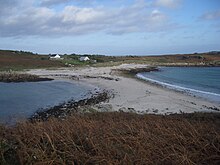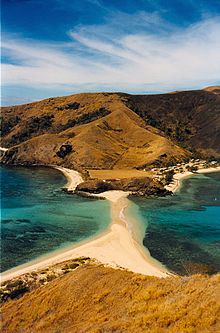
Back ضحضح Arabic Bar (relyef) Azerbaijani Beting BEW Banc de sorra Catalan Sandbanke Danish Sandbank German Sablobenko Esperanto Banco de arena Spanish Leetseljak Estonian Hondar-banku Basque



(Nosy Iranja, Madagascar)
In oceanography, geomorphology, and geoscience, a shoal is a natural submerged ridge, bank, or bar that consists of, or is covered by, sand or other unconsolidated material, and rises from the bed of a body of water close to the surface or above it, which poses a danger to navigation. Shoals are also known as sandbanks, sandbars, or gravelbars. Two or more shoals that are either separated by shared troughs or interconnected by past or present sedimentary and hydrographic processes are referred to as a shoal complex.[1][2]
The term shoal is also used in a number of ways that can be either similar to, or quite different from, how it is used in geologic, geomorphic, and oceanographic literature. Sometimes, the term refers to either any relatively shallow place in a stream, lake, sea, or other body of water; a rocky area on the seafloor within an area mapped for navigation purposes; or, a growth of vegetation on the bottom of a deep lake, that occurs at any depth, or is used as a verb for the process of proceeding from a greater to a lesser depth of water.[2]
- ^ Rutecki D, Nestler E, Dellapenna T, Pembroke A (2014). "Understanding the Habitat Value and Function of Shoal/Ridge/Trough Complexes to Fish and Fisheries on the Atlantic and Gulf of Mexico Outer Continental Shelf". Draft Literature Synthesis for the U.S. Dept. of the Interior, Bureau of Ocean Energy Management. Contract # M12PS00031. Bureau of Ocean Energy Management (DOI). p. 116.
- ^ a b Neuendorf, K.K.E., J.P. Mehl Jr., and J.A. Jackson, eds. (2005) Glossary of Geology (5th ed.). Alexandria, Virginia, American Geological Institute. 779 pp. ISBN 0-922152-76-4